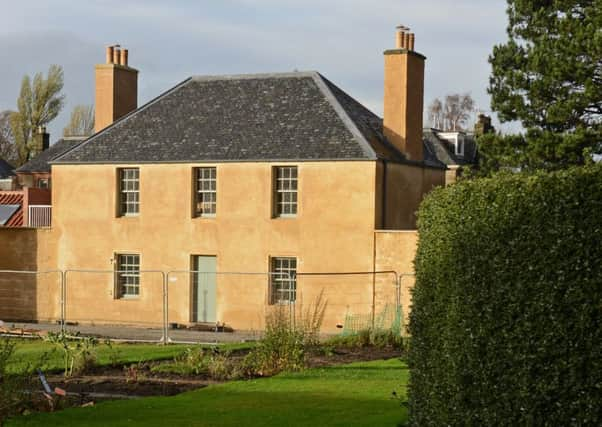Historic Edinburgh Botanic Cottage reopens after rebuilding
This article contains affiliate links. We may earn a small commission on items purchased through this article, but that does not affect our editorial judgement.


The Botanic Cottage, completed on 10 May 1766, stood at the entrance to the former site of the Royal Botanic Gardens Edinburgh (RBGE) in Leith Walk.
It was rescued from demolition in 2008, meticulously dismantled and transported one mile to the present RBGE site at Inverleith.
Advertisement
Hide AdAdvertisement
Hide AdThe Georgian building has now been re-assembled in a £1.6m project, using traditional techniques and historically accurate materials, as a state-of-the-art centre for community and education work.
Officially both the oldest and newest building at RBGE, the unique cottage’s upper floor will once again to function as a botany classroom.
Simon Milne, Regius Keeper at RBGE, said: “The completion of the Botanic Cottage is such an achievement for everyone involved.
“It has taken a lot of grit, determination, skill and commitment to get the building from Leith to Inverleith and reconstructed, and I appreciate the efforts of everyone who has played a part in bringing it back to life.
“As a focus for education and community work, the building is a perfect space. We hope that the groups using it in the years to come will be inspired to greatness by the history in the walls, the glorious setting and the unique craftsmanship around them.”
Regius Keeper John Hope, a leading figure of the Enlightenment, commissioned the building in 1764.
It was designed by John Adam, eldest of the Adam brothers in 1764, and extended in the 1780s by James Craig, author of the 1767 plan for the New Town of Edinburgh.
Records show that while craftsmen were finishing off small jobs on 10 May 1766, the very first medical students were arriving for teaching sessions in botany and horticulture.
Advertisement
Hide AdAdvertisement
Hide AdStudents taught there included Benjamin Rush, one of the founding fathers of the US; Sir Lucas Pepys who was George III’s physician during his “madness”; and Thomas Charles Hope who discovered the element strontium and taught Charles Darwin.
The building also served as the head gardener’s home and the main entrance to the Garden until RBGE moved to its present site in 1823 to take advantage of the fresher air.
It was then used as a private dwelling, and more recently as business premises, until 2008 when it was threatened with demolition for a new development.
The historic building was saved by a community campaign led by the Botanic Cottage Trust, and cash from individual donors and funding bodies including the Heritage Lottery Fund.
Lucy Casot, Head of the Heritage Lottery Fund in Scotland, said: “Today marks the end of the most incredible piece of conservation, and the beginning of a new lease of life for this historic cottage”.
The Botanic Cottage has been rebuilt like a giant jigsaw within the community and teaching gardens and will be at the heart of RBGE’s community education programme.
It features a spacious gathering room upstairs, where lectures used to be held, and downstairs, the heart of the “home” has a kitchen along with a potting shed and additional education space housed in the wings.
Groups of all ages will be able to use the lime-washed Cottage for classes, workshops, demonstrations, talks and meetings.
Advertisement
Hide AdAdvertisement
Hide AdSutherland Forsyth, RBGE’s community engagement coordinator for the Botanic Cottage project, said: “The Botanic Cottage reconstruction has been a project like no other.
“We are delighted that it once again provides an inspirational learning space that can be used by a wide range of school and community groups.
“We owe a great debt of thanks to the many campaigners and craftsmen that helped bring the Cottage back to life and for the support and huge interest we received in the project.”
Sue Whittle, partner with Simpson & Brown Architects, and the lead architect on the Botanic Cottage rebuild, said it had been a “once in a lifetime project”.
She added: “I doubt I will ever again have the opportunity to help rebuild and reinvigorate a building with such wonderful and extensive history.
“The Cottage has come home at last and long may it serve the Royal Botanic Garden Edinburgh and be inspirational to people of Edinburgh.”
The project has already been recognised, at the UK Georgian Group’s prestigious annual awards in December, when officials described the rebuild as “a heroic rescue of a garden building of real historic importance, and a triumph of craftsmanship and scholarly research”.
The Group added: “The upper floor in particular, which will function, once again, as a botany classroom, was beautifully restored.”
Advertisement
Hide AdAdvertisement
Hide AdLord Hope, of the Botanic Cottage Trust, said: “My kinsman, Dr John Hope, had he been alive today, would feel humbled by all the care and attention so many people have given to its preservation and reconstruction.
“He would be pleased by the way it has been so neatly adapted to the way we work in the modern world. And he would be delighted on being told about the use to which it is to be put.
“It is, as he would have wished, a place to be enjoyed by everyone.”
DOWNLOAD THE SCOTSMAN APP ON ITUNES OR GOOGLE PLAY
